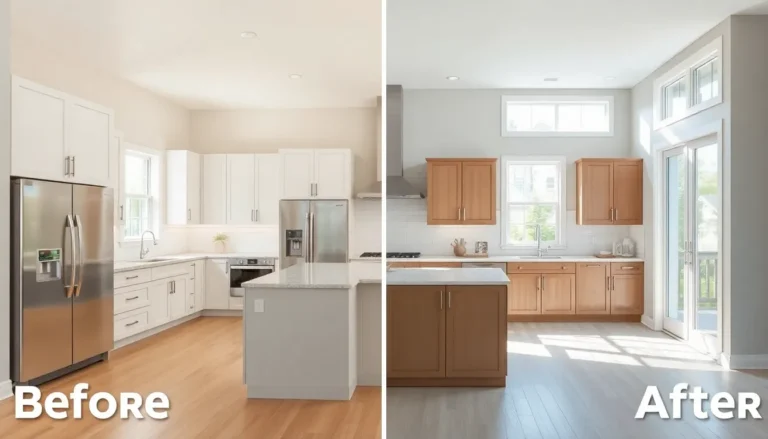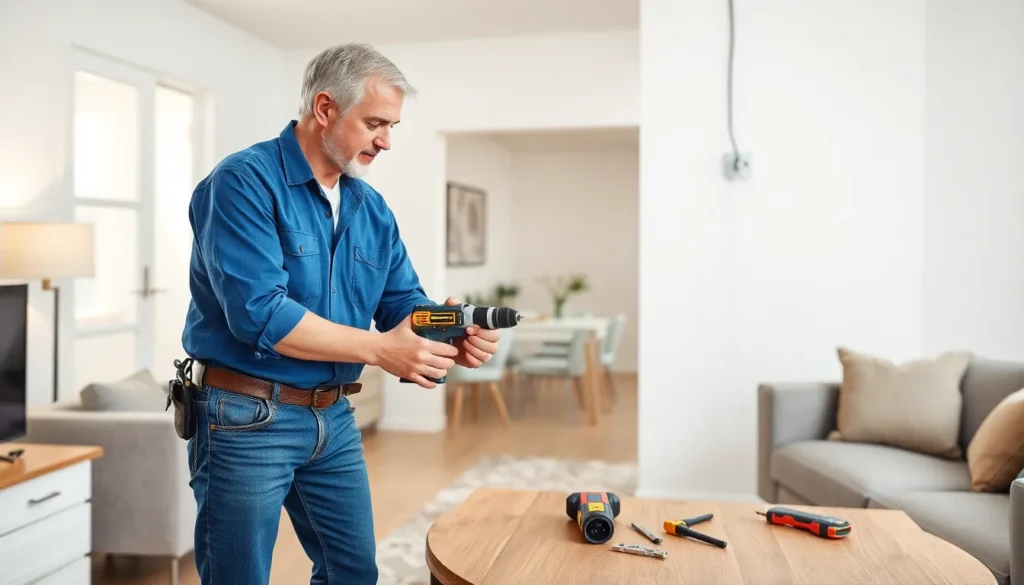Table of Contents
ToggleImagine a world where you don’t have to play a game of electrical hide-and-seek every time you want to charge your phone. Outlet relocation is the superhero you didn’t know you needed, swooping in to save your space from the chaos of tangled cords and awkwardly placed plugs. Whether it’s for a home renovation or simply to achieve that Pinterest-worthy aesthetic, moving outlets can transform your living space from “meh” to magnificent.
Understanding Outlet Relocation
Outlet relocation involves moving electrical outlets from their original positions to more convenient locations. This process enhances both the functionality and aesthetic appeal of spaces.
What Is Outlet Relocation?
Outlet relocation refers to the process of changing the position of electrical outlets. By repositioning outlets, homeowners can create a more organized living space. Placing outlets in optimal areas reduces cord clutter and improves access to power sources. Standard practices include moving outlets to meet design requirements or to accommodate new furniture layouts. A licensed electrician typically handles this process, ensuring compliance with local codes.
Importance of Outlet Relocation
Outlet relocation serves several essential purposes. First, it maximizes space by providing accessible power sources where needed. Improved outlet positioning decreases the likelihood of tripping over cords. Additionally, relocating outlets enhances the overall appearance of a room, creating a cleaner, more streamlined look. Energy efficiency can also improve, as strategically placed outlets support the use of power strips. Ensuring safety and convenience, this adjustment makes a significant impact during renovations or home updates.
Benefits of Outlet Relocation

Relocating electrical outlets offers various advantages that enhance both functionality and aesthetics in living spaces.
Improved Accessibility
Accessibility significantly improves when moving outlets to more convenient locations. Placing outlets near furniture or appliances eliminates the need for extension cords. Easy access to outlets means less hassle for users. Families with children benefit from safety by avoiding tripping hazards created by cords. Individuals can charge devices without difficulty, creating a more user-friendly environment. Furthermore, strategically positioned outlets support a neater look, keeping surfaces clear and organized.
Enhanced Aesthetics
Aesthetic enhancements arise from relocating outlets, contributing to a cleaner overall appearance. Outlets in hidden or less obvious locations reduce visual clutter. This simplification aligns with modern design trends that favor minimalism. Interior spaces feel more spacious when outlets are arranged thoughtfully. Coordinating outlet locations with furniture placement enhances the room’s flow. Consequently, residents enjoy an inviting atmosphere that showcases their personal style without distractions.
Challenges of Outlet Relocation
Outlet relocation presents some specific challenges that homeowners must navigate. While the benefits are clear, understanding potential hurdles helps in planning the process.
Cost Considerations
Costs arise from several factors when relocating outlets. Hiring a licensed electrician adds to expenses, given their expertise and compliance with local regulations. Labor costs can vary by region, making it essential to obtain multiple estimates. Besides labor, purchasing materials such as outlets and wiring incurs additional expenditure. Unexpected challenges during the project can lead to increased costs, especially if structural alterations impact electrical placement. Budgeting for these factors ensures a more accurate financial assessment.
Technical Difficulties
Technical challenges often arise during outlet relocation. Assessing the existing electrical system is crucial for determining the feasibility of the project. Wiring complications, such as inadequate lengths or insufficient circuits, present potential obstacles. Local building codes may dictate specific procedures, demanding familiarity with regulations. Identifying the best position for outlets requires careful consideration of furniture placement and room traffic patterns. Cutting into walls or ceilings may become necessary to accommodate new wiring, leading to additional work and precautions.
Best Practices for Outlet Relocation
Outlet relocation requires careful planning and execution. Adopting best practices ensures safety and efficiency throughout the process.
Hiring Professionals
Hiring a licensed electrician is crucial in outlet relocation. They ensure that all work complies with local building codes and safety standards. Relying on experts helps avoid potential hazards associated with improper wiring or placement. Electricians assess existing systems and manage complications that might arise during installation. Costs can vary, so obtaining multiple quotes can help in budget planning. It’s vital to discuss the desired outlet locations beforehand to align the project with personal preferences.
DIY Tips and Tricks
For those considering a DIY approach, several tips can enhance the experience. First, gather all necessary tools and materials, including a multimeter and circuit tester for safety. Always turn off power at the breaker box before beginning any work. Clearly marking the existing outlet locations can simplify the process. Researching local codes ensures compliance throughout the relocation. Using fish tape can facilitate running wires through walls and ceilings. Lastly, securing outlets with proper screws prevents movement or damage once installed.
Relocating electrical outlets can transform a living space by enhancing both functionality and aesthetics. With improved accessibility and reduced clutter, homeowners can create a more organized environment that aligns with modern design principles. While challenges like costs and technical difficulties may arise, the benefits often outweigh these concerns. Engaging a licensed electrician ensures compliance with safety standards and local codes, making the process smoother. For those considering a DIY approach, following best practices can lead to successful outcomes. Ultimately, thoughtful outlet relocation can lead to a safer and more inviting home, reflecting personal style while maximizing convenience.





